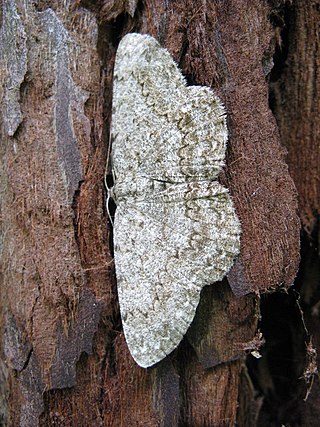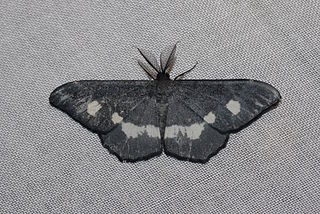
Lepidoptera or lepidopterans is an order of winged insects that includes butterflies and moths. About 180,000 species of the Lepidoptera have been described, representing 10% of the total described species of living organisms, making it the second largest insect order with 126 families and 46 superfamilies. and one of the most widespread and widely recognizable insect orders in the world.

Moths are a group of insects that includes all members of the order Lepidoptera that are not butterflies. They were previously classified as suborder Heterocera, but the group is paraphyletic with respect to butterflies and neither subordinate taxon is used in modern classifications. Moths make up the vast majority of the order. There are approximately 160,000 species of moth, many of which have yet to be described. Most species of moth are nocturnal, although there are also crepuscular and diurnal species.

The Sphingidae are a family of moths commonly called sphinx moths, also colloquially known as hawk moths, with many of their caterpillars known as "hornworms"; it includes about 1,450 species. It is best represented in the tropics, but species are found in every region. They are moderate to large in size and are distinguished among moths for their agile and sustained flying ability, similar enough to that of hummingbirds as to be reliably mistaken for them. Their narrow wings and streamlined abdomens are adaptations for rapid flight. The family was named by French zoologist Pierre André Latreille in 1802.

The geometer moths are moths belonging to the family Geometridae of the insect order Lepidoptera, the moths and butterflies. Their scientific name derives from the Ancient Greek geo γεω, and metron μέτρον "measure" in reference to the way their larvae, or inchworms, appear to measure the earth as they move along in a looping fashion. Geometridae is a very large family, containing around 23,000 described species; over 1400 species from six subfamilies are indigenous to North America alone. A well-known member is the peppered moth, Biston betularia, which has been the subject of numerous studies in population genetics. Several other geometer moths are notorious pests.

The Arctiinae are a large and diverse subfamily of moths with around 11,000 species found all over the world, including 6,000 neotropical species. This subfamily includes the groups commonly known as tiger moths, which usually have bright colours, footmen, which are usually much drabber, lichen moths, and wasp moths. Many species have "hairy" caterpillars that are popularly known as woolly bears or woolly worms. The scientific name Arctiinae refers to this hairiness. Some species within the Arctiinae have the word "tussock"' in their common names because they have been misidentified as members of the Lymantriinae subfamily based on the characteristics of the larvae.

The de Havilland DH.82 Tiger Moth is a 1930s British biplane designed by Geoffrey de Havilland and built by the de Havilland Aircraft Company. It was operated by the Royal Air Force (RAF) and other operators as a primary trainer aircraft. In addition to the type's principal use for ab initio training, the Second World War had RAF Tiger Moths operating in other capacities, including maritime surveillance and defensive anti-invasion preparations; some aircraft were even outfitted to function as armed light bombers.

The Boarmiini are a large tribe of geometer moths in the Ennominae subfamily.
Narulla is a monotypic moth genus of the family Erebidae. Its only species, Narulla infixaria, is found in Venezuela. Both the genus and species were first described by Francis Walker, the genus in 1861 and the species a year later in 1862.

Hyposidra is a genus of moths in the family Geometridae first described by Achille Guenée in 1857.

Semiothisa is a genus of moths in the family Geometridae. It was erected by Jacob Hübner in 1818.

Hyposidra picaria is a geometer moth in the Ennominae subfamily first described by Francis Walker in 1866. It is found throughout Sundaland.

The Erebidae are a family of moths in the superfamily Noctuoidea. The family is among the largest families of moths by species count and contains a wide variety of well-known macromoth groups. The family includes the underwings (Catocala); litter moths (Herminiinae); tiger, lichen, and wasp moths (Arctiinae); tussock moths (Lymantriinae), including the arctic woolly bear moth ; fruit-piercing moths ; micronoctuoid moths (Micronoctuini); snout moths (Hypeninae); and zales, though many of these common names can also refer to moths outside the Erebidae. Some of the erebid moths are called owlets.

Hyposidra talaca, the black looper or black inch worm, is a moth of the family Geometridae. The species was first described by Francis Walker in 1860. It is found from India to Indochina, Sundaland, Sulawesi, the Philippines, Sri Lanka, the Solomon Islands, Thailand, Taiwan, New Guinea and Australia, where it has been recorded from Queensland. It is a major defoliating pest in tea plantations.
Alphabaculovirus is a genus of viruses in the family Baculoviridae. The natural hosts of species in this family are invertebrates, among them winged insects, and decapods. However, species in this genus have been isolated only from the insect order Lepidoptera. There are 56 species in the genus.

Hyposidra violescens is a geometer moth in the Ennominae subfamily. It is found in Northwestern Himalaya, Northern Vietnam, Northern Thailand, Peninsular Malaysia, Sumatra, and Borneo. The species is infrequent in lowlands and lower montane forests.

Hyposidra aquilaria is a geometer moth in the Ennominae subfamily. It is found in Northwestern Himalaya, Western, Southern and Eastern China, Peninsular Malaysia, Sumatra, and Borneo. It is a rare species of lowland forests.

Hyposidra apioleuca is a geometer moth in the Ennominae subfamily. It is found in Peninsular Malaysia, Sumatra, and Borneo. The species prefers lower montane forests at 1000-1200m, but has been collected as low as 500m and at 1930m.














